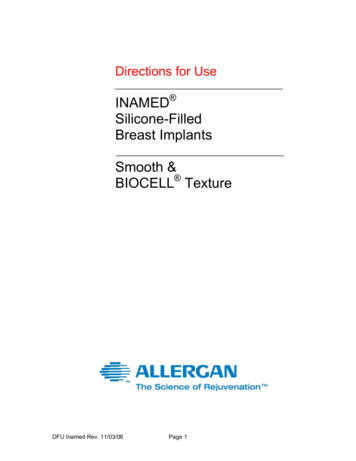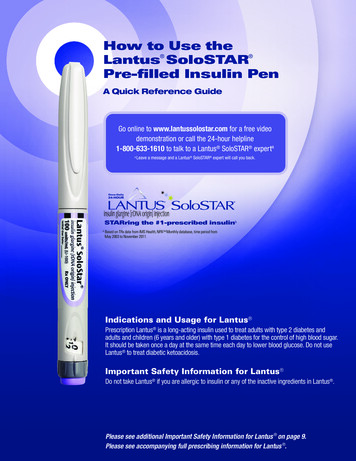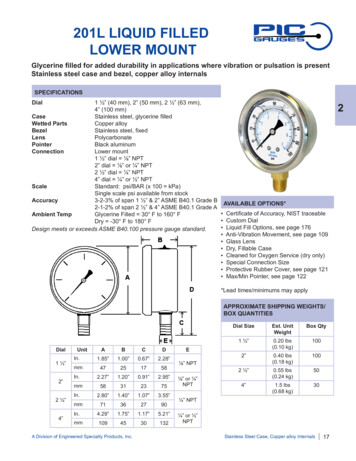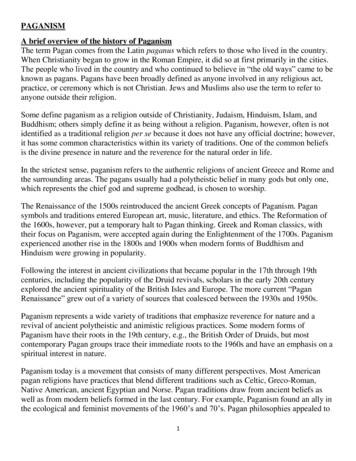
Transcription
Medical Examination ReportTo be filled in by the Doctor. The patient must fill in sections 9and 10 in the doctor’s presence (please use black ink).D4 Before filling in this form, please read Section B (page 5) of the‘Information and useful notes’ booklet (INF4D). Please ensure you fully examine the patient as well as takingthe patient’s history. Please answer all questions.Patient’s weight (kg)Height (cms)Details of smoking habits, if anyNumber of alcohol units taken each weekIs the urine analysis positive for Glucose?YesNo(please tick appropriate box)Details of type ofspecialist(s)/consultants, includingaddressDate of lastappointmentD D MM Y YD D MM Y YD D MM Y Ymedicationdosagereason takenDate when first licensed to drive a lorry1D D MM Y YD D MM Y Yand /or busVision (Please see Eyesight notes on page 7 and 8 of leaflet INF4D)Please tick the appropriate box(es)1. Is the visual acuity at least 6/9 in the better eye and at least 6/12 in the other?(corrective lenses may be worn) as measured with the full size 6m snellen chartYESNO (a) uncorrected acuity at least 3/ 60 in the right eye? (b) uncorrected acuity at least 3/ 60 in the left eye?(3/60 being the ability to read the 6/60 line of the full size 6m Snellen chart at 3 metres)(c) correction well tolerated? 2. Do corrective lenses have to be worn to achieve this standard?If YES, is the:-3. Please state the visual acuities of each eye in terms of the 6m Snellen Chart.Please convert any 3 metre readings to the 6 metre equivalentUncorrectedRightCorrected (if applicable)LeftRightLeft4. Is there a defect in the patient’s binocular field of vision (central and/or peripheral)?5. Is there diplopia? (controlled or uncontrolled)?6. Does the patient have any other ophthalmic condition?If YES to 4, 5 or 6, please give details in Section 7 and enclose any relevant visual field charts or hospital letters.Patient’s nameDate of Birth8/11
Nervous System2YESNO 1. Has the patient had any form of epileptic attack?If YES, please answer questions a–f(a) Has the patient had more than one attack? (b) Please give date of first and last attackFirst attackD D MM Y YD D MM Y YLast attack(c) Is the patient currently on anti-epilepsy medication?If Yes, please fill in current medication on the appropriate section on the front of this formD D MM Y Y(d) If no longer treated, please give date when treatment ended(e) Has the patient had a brain scan? If Yes, please state:MRI Date D D M M Y Y(f) Has the patient had an EEG?CT DateD D MM Y YPlease supply reports if availableD D MM Y Y If Yes to any of above, please supply reports if available.2. Is there a history of blackout or impaired consciousness within the last 5 years?If YES, please give date(s) and details in Section 73. Is there a history of, or evidence of, any of the conditions listed at a–g below?If NO, go to Section 3.If YES, please tick the relevant box(es) and give dates and full details at Section 7 and supply any relevant reports.(a) Stroke or TIA please delete as appropriateIf YES, please give dateD D MM Y YHas there been a full recovery?Please provide copies of any carotid artery and/or other major cerebral artery imaging reports.(b) Sudden and disabling dizziness/vertigo within the last 1 year with a liability to recur(c) Subarachnoid haemorrhage(d) Serious head injury within the last 10 years(e) Brain tumour, either benign or malignant, primary or secondary(f)Other brain surgery or abnormality(g) Chronic neurological disorders e.g. Parkinson’s disease, Multiple Sclerosis Diabetes Mellitus3YES1. Does the patient have diabetes mellitus?If NO, please go to Section 4If YES, please answer the following questions.2. Is the diabetes managed by:(a) Insulin?If YES, please give date started on insulinD D MM Y Y(b) If treated with insulin are there at least 3 months of blood glucose readings stored on a memory meter?(c) Other injectable treatments?(d) A sulphonylurea or a Glinide?(e) Oral hypoglycaemic agents and diet?If Yes, please fill in current medication on the appropriate section on the front of this form(f)Diet only?3. (a) Does the patient test blood glucose at least twice every day?(b) Does the patient test at times relevant to driving?(c) Does the patient carry fast acting carbohydrate in the vehicle when driving?(d) Does the patient have a clear understanding of diabetes and the necessary precautions for safe driving?4. Is there evidence of:(a) Loss of visual field?(b) Severe peripheral neuropathy, sufficient to impair limb function for safe driving?5. Is there any evidence of impaired awareness of hypoglycaemia?Patient’s nameDate of birth2NO
6. Has there been laser treatment for retinopathyor intra-vitreal treatment for retinopathy?YESNO YESNOIf YES, please give date(s) of treatment7. Is there a history of hypoglycaemia in the last 12 months requiring the assistanceof another person?If YES to any of 4–6 above, please give details in Section 7Psychiatric Illness4 Is there a history of, or evidence of, any of the conditions listed at 1–7 below? If NO, please go to Section 5If YES, please tick the relevant box(es) below and give date(s), prognosis, period of stabilityand details of medication, dosage and any side effects in Section 7.NB. Please enclose relevant hospital notesNB. If patient remains under specialist clinic(s), ensure details are filled in at the top of page 1.YES1. Significant psychiatric disorder within the past 6 months 2. A psychotic illness within the past 3 years, including psychotic depression3. Dementia or cognitive impairment4. Persistent alcohol misuse in the past 12 months5. Alcohol dependence in the past 3 years6. Persistent drug misuse in the past 12 months7. Drug dependence in the past 3 yearsCardiac55ACoronary Artery DiseaseYESNO Is there a history of, or evidence of, Coronary Artery Disease? If NO, go to Section 5BIf YES, please answer all questions below and give details at Section 7 of the form and encloserelevant hospital notes.1. Acute Coronary Syndromes including Myocardial Infarction?If YES, please give date(s)D D MM Y Y2. Coronary artery by-pass graft surgery?If YES, please give date(s)D D MM Y Y3. Coronary Angioplasty (P.C.I)If YES, please give date of most recent interventionD D MM Y Y4. Has the patient suffered from Angina?If YES, please give the date of the last known attackD D MM Y YPlease go to next Section 5BPatient’s nameDate of birth3
5BCardiac ArrhythmiaYESNO Is there a history of, or evidence of, cardiac arrhythmia? If NO, go to Section 5CIf YES, please answer all questions below and give details in Section 7 of the form.1. Has there been a significant disturbance of cardiac rhythm? i.e. Sinoatrial disease, significantatrio-ventricular conduction defect, atrial flutter/fibrillation, narrow or broad complex tachycardia in last 5 years2. Has the arrhythmia been controlled satisfactorily for at least 3 months?3. Has an ICD or biventricular pacemaker (CRST-D type) been implanted?4. Has a pacemaker been implanted?If YES:(a) Please supply date of implantationD D MM Y Y(b) Is the patient free of symptoms that caused the device to be fitted?(c) Does the patient attend a pacemaker clinic regularly?Please go to Section 5C5CPeripheral Arterial Disease (excluding Buerger’s Disease) Aortic Aneurysm/DissectionIs there a history or evidence of ANY of the following:If YES, please tick ALL relevant boxes below, and give details in Section 7 of the form.If NO, go to Section 5D1. PERIPHERAL ARTERIAL DISEASE (excluding Buerger’s Disease)2. Does the patient have claudication?If YES, for how long in minutes can the patient walk at a brisk pace before being symptom-limited?YESNO YESNO Please give details3. AORTIC ANEURYSMIF YES:(a) Site of Aneurysm:Thoracic Abdominal (b) Has it been repaired successfully?(c) Is the transverse diameter currently 5.5cms?D D MM Y YIf NO, please provide latest measurement and date obtained4. DISSECTION OF THE AORTA REPAIRED SUCCESSFULLY:If yes, please provide copies of all reports to include those dealing with any surgical treatment.Please go to Section 5D5DValvular/Congenital Heart DiseaseIs there a history of, or evidence of, valvular/congenital heart disease?If NO, go to Section 5EIf YES, please answer all questions below and give details in Section 7 of the form.1. Is there a history of congenital heart disorder?2. Is there a history of heart valve disease?3. Is there any history of embolism? (not pulmonary embolism)4. Does the patient currently have significant symptoms?5. Has there been any progression since the last licence application? (if relevant)Please go to section 5EPatient’s nameDate of birth4
5ECardiac OtherDoes the patient have a history of ANY of the following conditions:YESNO YESNO YESNO (a) a history of, or evidence of, heart failure?(b) established cardiomyopathy?(c) a heart or heart/lung transplant?(d) Untreated atrial myxomaIf YES, please give full details in Section 7 of the form. If NO, go to section 5F5FCardiac InvestigationsThis section must be filled in for all patients 1. Has a resting ECG been undertaken? If YES, does it show:(a) pathological Q waves?(b) left bundle branch block?(c) right bundle branch block?Please provide a copy of the ECG report (if available) or comment at Section 72. Has an exercise ECG been undertaken (or planned)?If YES, please give dateD D MM Y Yand give details in Section 7Please provide relevant reports if available3. Has an echocardiogram been undertaken (or planned)?(a) If YES, please give dateD D MM Y Yand give details in Section 7(b) If undertaken, is/was the left ventricular ejection fraction greater than or equal to 40%?Please provide relevant reports if available4. Has a coronary angiogram been undertaken (or planned)?If YES, please give dateD D MM Y Yand give details in Section 7Please provide relevant reports if available5. Has a 24 hour ECG tape been undertaken (or planned)?If YES, please give dateD D MM Y Yand give details in Section 7Please provide relevant reports if available6. Has a Myocardial Perfusion Scan or Stress Echo study been undertaken (or planned)?If YES, please give dateD D MM Y Yand give details in Section 7Please provide relevant reports if availablePlease go to Section 5G5GBlood PressureThis section must be filled in for all patients 1. Is today’s best systolic pressure reading 180mm Hg or more?2. Is today’s best diastolic pressure reading 100mm Hg or more? Please give today’s reading3. Is the patient on anti-hypertensive treatment?If YES to any of the above, please provide three previous readings with dates, if availablePatient’s nameDate of birth5
General6Please answer all questions in this section. If your answer is ‘YES’ to any of the questions, please givefull details in Section 7.1. Is there currently a disability of the spine or limbs likely to impair control of the vehicle?2. (a)Is there a history of bronchogenic carcinoma or other malignant tumour, for example, malignantmelanoma, with a significant liability to metastasise cerebrally?YESNO If YES, please give dates and diagnosis and state whether there is current evidence of dissemination(b)Is there any evidence the patient has a cancer that causes fatigue or cachexia that affects safe driving?3. Is the patient profoundly deaf?If YES,is the patient able to communicate in the event of an emergency by speech or by using a device,e.g. a textphone?4. Does the patient have a history of alcoholic liver disease and/or liver cirrhosis of any origin?If YES, please give details in Section 75. Is there a history of, or evidence of, sleep apnoea syndrome?If YES, please provide details6.D D MM Y Y(a)Date of diagnosis(b)Is it controlled successfully?(c)If YES, please state treatment(e)Please provide neck circumference(f)Please provide girth measurement in cms(g)Date last seen by consultant(d) Please state period of controlDoes the patient suffer from narcolepsy or cataplexy?If YES, please give details in Section 77. Is there any other Medical Condition causing excessive daytime sleepiness?If YES, please provide details(a)Diagnosis(b)Date of diagnosis(c)Is it controlled successfully?(d)If YES, please state treatment(f)Date last seen by consultantD D MM Y Y(e) Please state period of control8. Does the patient have severe symptomatic respiratory disease causing chronic hypoxia?9. Does any medication currently taken cause the patient side effects that could affect safe driving?If YES, please provide details of medication and symptomsh10. Does the patient have any other medical condition that could affect safe driving?If YES, please provide detailshPatient’s nameDate of birth6
Please forward copies of relevant hospital notes only. Please do not send anynotes not related to fitness to drive7Patient’s nameDate of BirthMedical Practitioner DetailsTo be filled in by Doctor carrying out the examinationPlease ensure all relevant sections of the form have been filled in as, if not, this will cause the form to bereturned for completion.8Doctor’s details (please print name and address in capital letters)Surgery Stamp or GMC Registration NumberNameAddressTelephoneEmail addressFax numberDate ofExaminationSignature of Medical Practitioner7
Patient’s DetailsTo be filled in in the presence of theMedical Practitioner carrying out the examinationD4Please make sure that you have printed your name and date of birthon each page before sending this form with your application9Your detailsYour full nameDate of BirthYour addressHome phone numberD D MM Y YWork/Daytime numberEmail addressAbout your GP/Group PracticeGP/Group nameAddressPhoneEmail addressFax number10Patient’s consent and declarationConsent and DeclarationThis section MUST be filled in and must NOT be altered in any way.Please read the following important information carefully then sign to confirm the statements below.Important
(3/60 being the ability to read the 6/60 line of the full size 6m Snellen chart at 3 metres) (c) correction well tolerated? 3. Please state the visual acuities of each eyein terms of the 6m Snellen Chart. Please convert any 3 metre readings to the 6 metre equivalent Uncorrected Corrected (if











